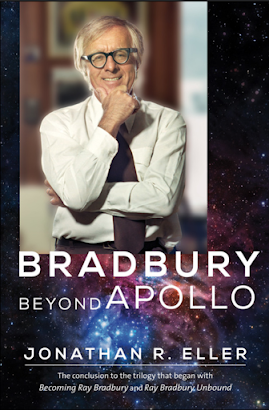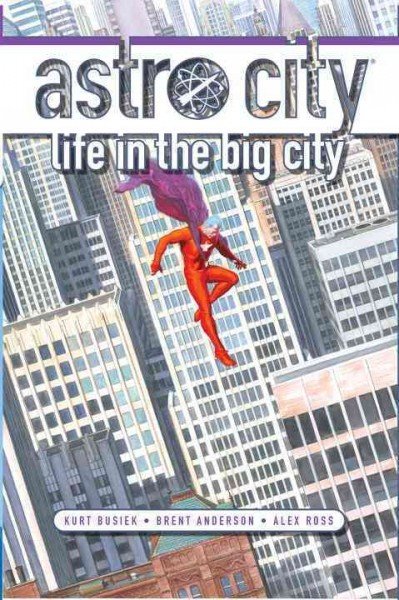A Bradbury roundup to wind up this Thanksgiving holiday weekend.
(1) TEN CENTS A DANCE. Input expresses its gratitude: “We have dime-operated rental typewriters to thank for ‘Fahrenheit 451’”.
…DRIVEN BY COST AND CHILDREN — Open Culture has seen fit to remind us all that the classic novel had humble beginnings. Typed on a rental typewriter for $9.80 at a dime per half an hour, the book began as a 25,000-word novella called The Fireman. Over the course of nine days, Bradbury spent 49 hours on this first draft.
His speed was largely driven by the sheer cost (we’re talking mid-century dimes here) and the ticking clock of being a present father. Surely, as more parents have had to attempt working from home while their children are being adorable, you can understand why Bradbury could no longer write from his garage. Unable to afford an office, he turned to rental typewriters in the basement of UCLA’s Powell Library.
(2) MYSTERIOUS RAY. In the Los Angeles Review of Books, Cullen Gallagher is enthusiastic about the Hard Case Crime collection Killer, Come Back To Me, a collection of Bradbury’s crime fiction — “Bradbury Noir: The Crimes of a Science Fiction Master”.
THE SKELETONS IN Ray Bradbury’s closet are out in Killer, Come Back to Me, a career-spanning collection of the science fictioneer’s crime stories. These 300 pages present a new side to readers who only know Bradbury from such classics as The Martian Chronicles (1950) and Fahrenheit 451 (1953). Published by Hard Case Crime on the occasion of the author’s centennial, the selections were picked by Hard Case head honcho Charles Ardai, Michael Congdon (Bradbury’s longtime agent), and Jonathan R. Eller (director of the Center for Ray Bradbury Studies at Indiana University and author of, among other titles, Becoming Ray Bradbury, Ray Bradbury Unbound, and Bradbury Beyond Apollo). Encompassing everything from the early pulp work on which he cut his teeth to a story published two years before his death in 2012, Killer, Come Back to Me offers the full spectrum of Bradbury’s criminal imagination.
… Bradbury’s life of crime spanned seven decades. Unlike Elmore Leonard and Brian Garfield, who started with Westerns, then moved to mysteries and didn’t look back, Bradbury never left the mystery genre for good. His commitment to both crime and SF recalls the career of Fredric Brown, who, while 14 years older, only entered the pulps shortly before Bradbury did and divided his output between the two genres until his death in 1972. Like Brown, Bradbury’s work displays the influence of Weird Tales and Dime Detective (where both authors published), embedding elements of the bizarre and supernatural in murder mysteries. Among Bradbury’s weirdest stories is a Dime yarn called “Corpse Carnival” (July 1945), which begins with one of two conjoined twins witnessing the murder of the other.

(3) HE WALKS BY NIGHT. Literary Hub considers Bradbury’s “The Pedestrian” in “The Dissident Act of Taking a Walk at Night”.
…He is half-consciously creating what Paul Farley and Michael Symmons Roberts, in their celebration of the edgelands that characterize the uncertain border between cities and the surrounding countryside, have classified as “desire paths.” These are “lines of footfall worn into the ground” that transform the ordered, centralized spaces of the city into secret pockets; and that, in so doing, offer a “subtle resistance to the dead hand of the planner.”
Once he has decided on a direction, Mead strides off along his desire path, then, at once purposeful and purposeless. “Sometimes he would walk for hours and miles and return only at midnight to his house.” Mead has never encountered another living creature on these nighttime walks. Nor has he so much as glimpsed another pedestrian in the daytime, because people travel exclusively by car. “In ten years of walking by night or day, for thousands of miles, he had never met another person walking, not once in all that time” (569).
The proximate reason for the eerie solitude of the city at night is that everyone else has carefully secluded themselves in their living rooms in order to stare blankly and obediently at television screens. The silence of the city is an effect of what Theodor Adorno once called “the unpeaceful spiritual silence of integral administration.” If there is no political curfew in place in Bradbury’s dystopian society, this is because a kind of cultural or moral curfew renders it superfluous.
Crossing and re-crossing the city at night on foot, aimlessly reclaiming the freedom of its streets from automobiles, Bradbury’s Pedestrian is identifiable as the scion of a distinct tradition of urban rebellion or resistance, the dissident tradition of the nightwalker….
(4) OUT ON A LIMB. “The Best History Lesson Ever: Ray Bradbury and ‘The Halloween Tree’” at Bloody Disgusting.
…With the seminal dark fantasy masterpiece Something Wicked This Way Comes (1962) and the latter career work A Graveyard for Lunatics: Another Tale of Two Cities (1990) on either side, The Halloween Tree is the middle installment in a loose Halloween trilogy by the author. Though he had written several other pieces dealing with childhood and growing up in a small town, this is his only novel that is aimed directly at children as its primary audience. Be that as it may, it is enchanting for readers of all ages. It is also well worth mentioning that the illustrations by Joseph Mugnaini, a frequent collaborator of Bradbury’s, are astounding.
In 1993, the Hanna-Barbera company produced an animated special based on the novel for the ABC network written and narrated by Bradbury himself with Leonard Nimoy voicing the mysterious Mr. Moundshroud. So often when it comes to books and the movies based on them, one is clearly superior. In this case, both are so wonderful for different reasons that neither feels extraneous. The basics of the plot remain more or less the same in both, but the details and execution in each make both vital. Because they share most of the same plot points, let us explore both at the same time, reveling in the magic of each.
(5) PAST THE APEX. In “Bradbury in the Afternoon” at the Russell Kirk Center website, James E. Person, Jr. does a lengthy review of Jonathan R. Eller’s bio Bradbury: Beyond Apollo.

…By that time Bradbury was a legend: he was hailed and feted by his writing peers and admiring readers of all ages, his name mentioned in the same breath with H. G. Wells and Jules Verne as a writer of astonishingly imaginative science fiction and fantasy. Within the world of literature he knew everybody that was anybody, and his works were well on their way to becoming staples of middle-school and high-school literature courses. So what did the man do for the remaining fifty years of his life? The answer is hinted at in the title of the third and final volume of Jonathan Eller’s masterful Bradbury biography, by the words “Beyond Apollo.”
Why those words? Their significance lies in that from Bradbury’s perspective, the Apollo moon landings—particularly the initial landing in July, 1969—marked the apex of much that the author had dreamed of, the first step in mankind’s outward journey to Mars and beyond. When Neil Armstrong and Edwin (“Buzz”) Aldrin first set foot on the moon at Tranquility Base, it marked the pinnacle of the U.S. space program’s endeavors at that time. Everything that followed—the subsequent handful of successful moon landings, the space-shuttle initiative, the probes to Mars and beyond, the international space station—were wonderful but somehow a step down. As with Bradbury’s career, there was a sense that there was nothing left to prove. Beyond Apollo, there was a transitional phase of reset and refocus in America’s approach to space exploration and in Bradbury’s career….
(6) HEY, I KNOW THAT GUY. Phil Nichols’s seventeenth episode of his series “Bradbury 100” spotlight’s some events celebrating the milestone birthday. John King Tarpinian restrained his enthusiasm when he sent the link: “Darn it, I am included in this podcast at about 7 minutes in.”

This week’s Bradbury 100 is a bit different: instead of a featured guest interview, I present highlights from two Bradbury Centenary events from recent times, as well as summing up some of the key centenary events of the year so far.
The first of the highlights is a selection from the discussion in the first (and so far, only) Bradbury 100 LIVE episode. This was an event I ran on Facebook Live back in September. In this recording, I talk to John King Tarpinian – a friend of Ray Bradbury’s who often accompanied him to public events – and educator George Jack.
The second is the audio from a public lecture I gave earlier this week, celebrating seventy years of Bradbury’s book The Martian Chronicles.
(7) COVID-19 PUSHES 451 OUT OF THE SYLLABUS. In the Washington Post, Ashley Fetters interviewed teachers about the changes they’ve made as a result of the pandemic. She interviewed Morgan Jackson, a high school English teacher in Philadelphia: “Distance learning is straining parent-teacher relationships”.
…Jackson has made changes to how she teaches. She skipped, for example, a lesson she planned about an overdose scene in Fahrenheit 451. ‘Typically, because Philadelphia is so rife with overdoses and drug issues, I would have had an in-depth discussion and read an article about that. But because it’s such a controversial topic and some parents don’t want their kids knowing about that side of Philly, I kind of cut that out,’ she said. ‘I feel more monitored now than I did when we were in class.’
(8) THAT’S SHAT. [Item by Martin Morse Wooster.] This is from an article by David Cheal in the November 21 Financial Times about Elton John’s 1972 song “Rocket Man.”
Decades before the opening scenes of Ridley Scott’s film Alien (1979) showed astronauts smoking, chatting, and drinking, before John Carpenter’s 1974 sci-fi classic Dark Star depicted a spaceship’s crew bored and listless, science-fiction writer Ray Bradbury had the prescience to realise that one day going ino space would be just a job. His short story ‘The Rocket Man,’ part of his 1951 collection The Illustrated Man, tells of a man who works in space for three months at a time, coming home to an anxious wife and a curious teenage son. Sniffing his father’s space uniform, the son finds it smells of ‘fire and time.”…
…In 1972 Bernie Taupin, Elton John’s lyric-writing partner, was heading home to see his parents. He had read Bradbury’s story and was musing on it when a lyric popped into his head, about a man preparing to head off to his job in space: ‘She packed my bags last night pre-flight, zero hour 9am… Taupin normally used a notebook to jot down ideas but as he was driving he had to spend the day anxiously memorizing the lines before he could finally commit them to paper. He sent the finished lyric to John (they mostly work separately), who set them to music,'”
Cheal notes that when William Shatner sang his version of “Rocket Man” at the Science Fiction Film Awards ceremony, Ray Bradbury was in the audience as he later gave the prize for best film of the year to Star Wars.
(9) FAN MAIL. Maddy Schierl remembers her response to a life-changing fictional encounter — “Door Reader Series: Fahrenheit 451” in the Door County Pulse.
I was in seventh grade the first time that I read Ray Bradbury’s Fahrenheit 451. I wasn’t a particular fan of science fiction, nor was I a fan of dystopian fiction. That being said, Fahrenheit 451 didn’t even register as belonging to a genre as I read it.
Bradbury’s language was so rich and real and immediate that I remember being as convinced of the world he built as I was of any “real” setting. I wanted to sink into every sentence. I wanted to wrap myself up in unexpected metaphors and lush allusions. I wanted to be a writer just like Bradbury.
After school the day that I finished reading Fahrenheit 451, I sat down to write Bradbury a letter. In this letter, I tried to express how much his book meant to me. I don’t remember now exactly what I wrote; I’m sure it was clumsy. What I do remember is including a small postscript informing him that I had enclosed an original short story, and would he please respond with any comments he might have.
Then I decorated the envelope with red and orange flames and stuck three stamps in the corner because it was so heavy. (It might have been generous to call my short story short.)
The next day, Ray Bradbury passed away. He was 91 years old, and my letter never got to him. I was devastated. Now, at 21 years old, I often wonder where that letter ended up.
[Thanks to John King Tarpinian, Martin Morse Wooster, and Michael J. Walsh for these stories.]



